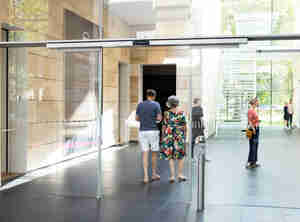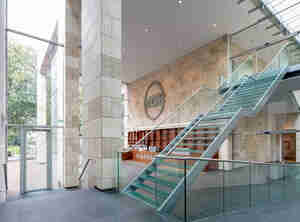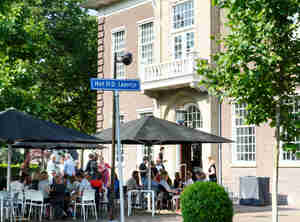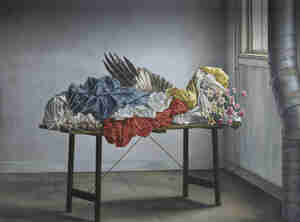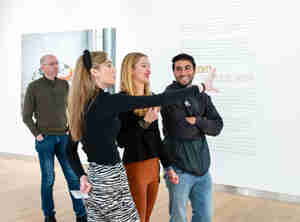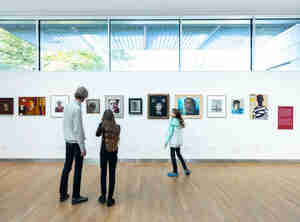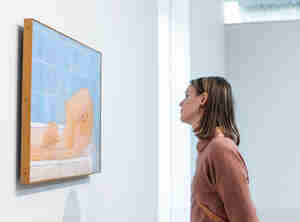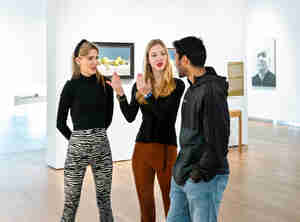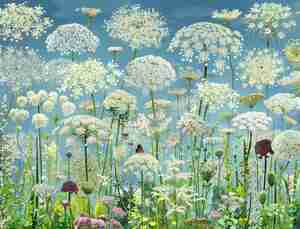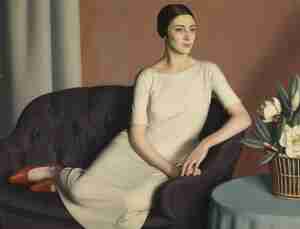Opening this fall, Museum MORE will present the first museum solo exhibition of the work of artist Lara de Moor (1969). Through her paintings, 30 of which will be on display at MORE, De Moor creates a mysterious world where abandoned places acquire a soul and their own distinctive atmosphere.

Illusion and eloquence
De Moor’s often monumental interior scenes are carefully orchestrated still lifes. Within these empty rooms, the floors, walls, windows, and corners coalesce into almost geometric compositions. Yet amidst this structured stillness, unexpected elements emerge – a transparent bag filled with water suspended from a doorknob or a wondrous web of luminous threads weaving through space.
Nothing in De Moor’s work in incidental. Sher looks for places, in her own home or elsewhere, that lend themselves to creating installations. She meticulously stages her objects and then photographs them as preliminary studies, translating these arrangements into oil on canvas. It is only then that the illusion and eloquence of her art fully manifest themselves. Through this process, De Moor imbues spaces with a sense of mystery and intrigue, as a space fills with question marks over a pile of blankets on a bed. Only then does the tension arise of an unoccupied room overlooking nature, silently encroaching upon the seemingly ordered human world.
Dripping cloud
While traces of human presence may still emanate warmth in De Moor’s paintings, it is usually unfathomable how long a ‘relic’ has been there, or will remain. The artist occasionally ventures into the realm of Surrealism, draping a peach-coloured dress with dangling lead balls over a chair. Although such a configuration is plausible in reality, it elicits an uncanny effect. Similarly, a large dark cloud drifting into a room appears as a sudden surge of violent emotion. Upon closer inspection, it reveals itself as a dripping stroke of black paint applied over an open door and a wall. Through these interventions, De Moor’s work delicately balances between reality and distortion, offering glimpses of familiarity filtered through her deeply personal thoughts and feelings.


Whispering paintings
For De Moor, a painting encapsulates a still point amidst a revolving world: ‘Time seems to have solidified in the abandoned spaces I so often paint, the air is no longer stirred, and the traces of the last actions are frozen within the objects.’ Joost Zwagerman aptly described De Moor’s work as follows: ‘(...) It is a silence that murmurs behind the canvas of the painting. We don't know who is murmuring, they are whispering paintings, where at the same time much has happened or is about to happen.’
Lara de Moor (1969)
Currently De Moor resides and works in Rotterdam. She graduated from the Gerrit Rietveld Academy in 1993 and subsequently participated in the two-year international residency programme at the Rijksakademie van Beeldende Kunsten in Amsterdam. She has exhibited widely in the Netherlands as well as abroad in London, Barcelona, Turin, Genoa and several German cities. Her work can be found in numerous private and public art collections. Museum MORE has acquired and added several pieces by her to its own collection in recent years.


Book
The first comprehensive survey of Lara de Moor’s work, titled Still Point, will accompany the exhibition at Museum MORE.
Available in Dutch and English, the book contains large colour and detail illustrations, offering a clear and insightful overview of De Moor’s recent oeuvre. A separate section includes photographs and notes detailing her working method, affording an understanding of her thought process and the interventions she makes in abandoned houses and spaces. Jurriaan Benschop wrote an essay especially for this book titled Lichtval (Fall of Light). Still Point, a 144-page book, will be published in mid-September by Lecturis Publishers. ISBN 978-94-6226-488-5. It will also be available on sale at the museum shop in Gorssel.
In his essay for Still Point, Jurriaan Benschop observes that: ‘In her paintings, several layers of time seem to have accumulated and come to rest. A certain atmosphere or tension is present, revealing neither the underlying reason nor the stories behind the objects. This quality allows her artwork to serve as a compelling surface onto which viewers can project their own memories, feelings, thoughts.’
